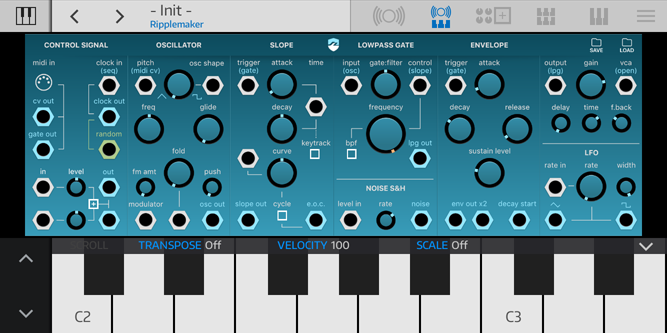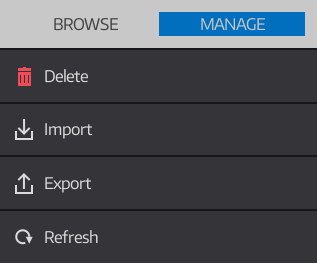

Overview
PERFORM
PATCH
AU Compatibility
The AU (or Audio Unit) Instrument is used to control and play a 3rd party AUv3 plugin instrument.
  |
Quick links: Overview PERFORM PATCH AU Compatibility |
Use the AU Instrument to control and play a 3rd party AUv3 instrument installed on your device. The AU Instrument sends the track's MIDI messages (such as note and controller events) to the Audio Unit and then captures the Audio Unit's audio output to send back to the mixer.
The AU instrument behaves very much like one of NanoStudio's internal instruments. It saves the AU's current settings inside your project so that when the project is reloaded it can automatically create the correct AU plugin and restore its settings back to their original state.
The AU instrument also acts as a central library for all your Audio Unit patches by automatically maintaining a database of all the AUs and AU patches currently installed on your device.
Use the PERFORM page to control the AU instrument using either the AU's own native editor or NanoStudio's standard keyboard and macro controls.
Use the PATCH page to browse and search for any AU patch with the ability to filter by AU, tag attributes or text search.
AU patches are divided into 2 classes:
 |
User patches are patches you've saved. When saving a user patch you can add tag attributes to describe it, which may be used later to find the type of sound you want. |
 |
Factory patches usually come with most AUs, but not all AUs provide them. If an AU doesn't provide any factory patches of its own then the AU Instrument will automatically create a single factory patch named Default. Factory patches are read-only and don't support tag attributes, but you're free to edit them and save them as user patches. |
The perform page is accessed by enabling the PERFORM tab button (highlighted in GREEN in the image below).

Use the LEFT/RIGHT ARROWS on the left of the title bar to browse patches as you play. The available patches are filtered according to the patch attributes currently set in the PATCH page.
Use the VIEW BUTTONS on the right of the title bar to select the desired view:
AU FULL SCREEN |
Dedicates the entire performance page to the AU's native editor UI. Note: Some AUs won't take advantage of the full screen view. |
|
AU SPLIT KEYS |
Dedicates the top half of the performance page to the AU's native editor UI and the bottom half to the keyboard. Note: Some AUs won't resize for the split view, although most will allow you to scroll their editor vertically by dragging on its background. In some cases, you will have no choice but to use the full screen view in order to gain access to all the controls available in the AU's native editor UI. |
|
MACROS |
Dedicates the top half of the performance page to the macro controls and the bottom half to the keyboard. When the macro controls are visible, tap the HAMBURGER BUTTON in the top right corner of the perform page to invoke the Macro Tools menu. |
|
DUAL KEYS |
Shows two keyboards. | |
FULL KEYS |
Dedicates the entire performance page to a single large keyboard. |
You can access settings for the keyboard by tapping on the button highlighted in GREEN in the image below.

Use the bar to lock or unlock HORIZONTAL SCROLLING or to set the keyboard's TRANSPOSE, VELOCITY or SCALE.
Any settings you change via the bar are applied globally to all keyboard-based instruments in the project.
You can change the width of the keys in the Settings page.

The perform page has 10 macro controls, consisting of 8 rotary knobs and 2 X/Y pad axes.
When the macro controls are visible, tap the HAMBURGER BUTTON in the top right corner of the perform page to invoke the Macro Tools menu.
 |
Use the menu to initialize, swap or rename macro controls, or to map them to a modulation destination. Some AUs provide a list of 'main parameters'. If so, the AU Instrument will automatically set up the macro controls for the first 10 parameters in the list. |
The patch page is shown when the PERFORM tab button (highlighted in GREEN in the image below) is disabled.
It provides the following features:

The page is divided into an AU List, a Tag Attribute List and a Patch List.
 |
BROWSE MODE The tick icon shows the AU which is currently loaded. TAP on an item to select the AU you'd like to browse. You can browse the patches for all AUs by selecting All, or narrow your search down by selecting a particular AU. DOUBLE TAP on an AU to load its default factory patch. |
 |
MANAGE MODE Use this mode to manage your user patches. When MANAGE is selected, the patch list allows multiple selection so that you can easily perform bulk operations. The AU Instrument automatically keeps its patch database up to date, but if you think you have some missing patches then you can use the Refresh option to manually rebuild its database. For Import and Export options, see Integration and Sharing. |
 |
Selects the type of sound you'd like to browse according to its tag attributes. Note: Only user patches support tag attributes. When AND mode is selected, the patch must contain all the selected tags in order to be shown. When OR mode is selected, the patch must contain at least one of the selected tags in order to be shown. |
 |
Shows a list of the patches which match the currently selected bank and tag attributes. Use the TEXT SEARCH on the title bar to narrow your search. TAP to load a patch. |
 |
TAP THE HAMBURGER BUTTON in the top right corner to open the menu. Use the menu to save, delete, copy and paste patches. Copy/paste works between other AU Instruments and projects. |
There are many 3d party Audio Unit plugins available in the App Store. They have been created by many different developers and documentation is hard to come by, so there are sometimes differences in the way hosts or plugins behave.
If an AU is being problematic it can often be difficult to tell if it is a problem with NanoStudio or the AU itself. If you have another app which is capable of hosting AU instruments, a good test is to try the AU in that app. If the AU behaves similarly in a different host then the problem most probably lies with the AU. If the AU functions correctly in a different host then the problem probably lies with NanoStudio, in which case we'd like to hear about it!
Here are some common problems we have seen with the AUs we've tested: